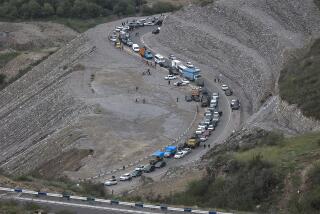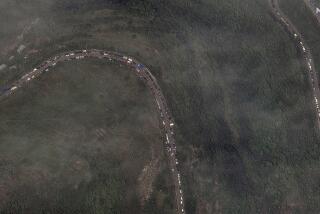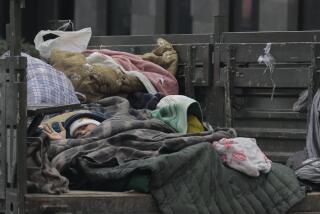11 More Reported Dead in Armenia Strife
MOSCOW — Eleven more people were killed in clashes between Armenians and Azerbaijanis over the past week as communal violence spread through the southern Soviet republic of Armenia, an official news agency reported Wednesday.
The latest deaths, mostly Azerbaijanis, brought the known toll in Armenia and neighboring Azerbaijan to 19.
The fighting is the worst outbreak of ethnic strife since 32 people, 26 of them Armenians, were killed last February in the Azerbaijani city of Sumgait. Nearly 60 people have died in the unrest in the two Soviet republics.
Quoting the military command, the official news agency Armenpress reported that 10 Azerbaijanis and one Armenian had been killed in clashes between Armenian “self-defense groups” and Azerbaijani bands described as fighting “a partisan war” from the hills.
The deaths occurred mostly in northern Armenia and included two that had been reported earlier. Eight other people, including three soldiers, were killed last week in the Azerbaijani city of Kirovabad after a series of Azerbaijani attacks on the Armenian minority there.
Tensions remain high in both republics, according to the official Soviet news media, which warned Wednesday that authorities were prepared to send “as many troops and as many tanks as will be required to maintain law and order.”
Armenian President Grant Voskanyan, addressing the Supreme Soviet, the national Parliament, as it considered political reforms, blamed Azerbaijan for the renewed violence. The failure of Azerbaijani officials to condemn the anti-Armenian massacres in Sumgait had led to the initial attacks last week and then to counterattacks throughout the two republics, he charged.
On Tuesday, Azerbaijani President Suleiman Tatliev had told the Supreme Soviet that continuing Armenian demands for the annexation of Nagorno-Karabakh, a largely Armenian enclave in Azerbaijan, had raised tensions to the breaking point.
Broke Fragile Peace
Azerbaijanis also contend that Armenia broke the fragile peace by starting construction on a small industrial workshop in Nagorno-Karabakh, a project they saw as an Armenian attempt to strengthen its claim in the disputed region by moving more of their own people there. And they charged that the construction desecrated an Azerbaijani shrine commemorating an ancient victory over invading Persians.
But the continuing protests in Baku, the Azerbaijani capital, have taken on an increasingly nationalistic and Islamic tone, according to Soviet correspondents reporting from the city.
Pictures of the Ayatollah Ruhollah Khomeini, Iran’s supreme leader, have been carried in Baku’s Lenin Square; green Islamic banners and some Turkish flags have been unfurled, and demonstrators’ speeches are said to be focusing on nationalistic grievances against the central government, rather than on the Nagorno-Karabakh issue alone.
The deaths reported Wednesday occurred over the past week in the Armenian towns of Kalinino, Kirovakan, Krasnoselsk and Spitak, all in northern Armenia, and in Goris in southeastern Armenia, according to Armenpress. Few other details were available.
Both Armenia and Azerbaijan have been placed under effective military control in an effort to restore order. Movements are now restricted in both republics, curfews have been imposed and meetings, rallies and strikes are banned.
The official Soviet news media reported Wednesday that troop reinforcements had prevented more fighting but that they had not been able to reduce tensions.
Arrests now total more than 1,000 in Azerbaijan alone, according to Soviet authorities.
Thousands of refugees are arriving daily by road and by air in Armenia from Azerbaijan, with a smaller flow of Azerbaijanis out of Armenia.
More to Read
Sign up for Essential California
The most important California stories and recommendations in your inbox every morning.
You may occasionally receive promotional content from the Los Angeles Times.










